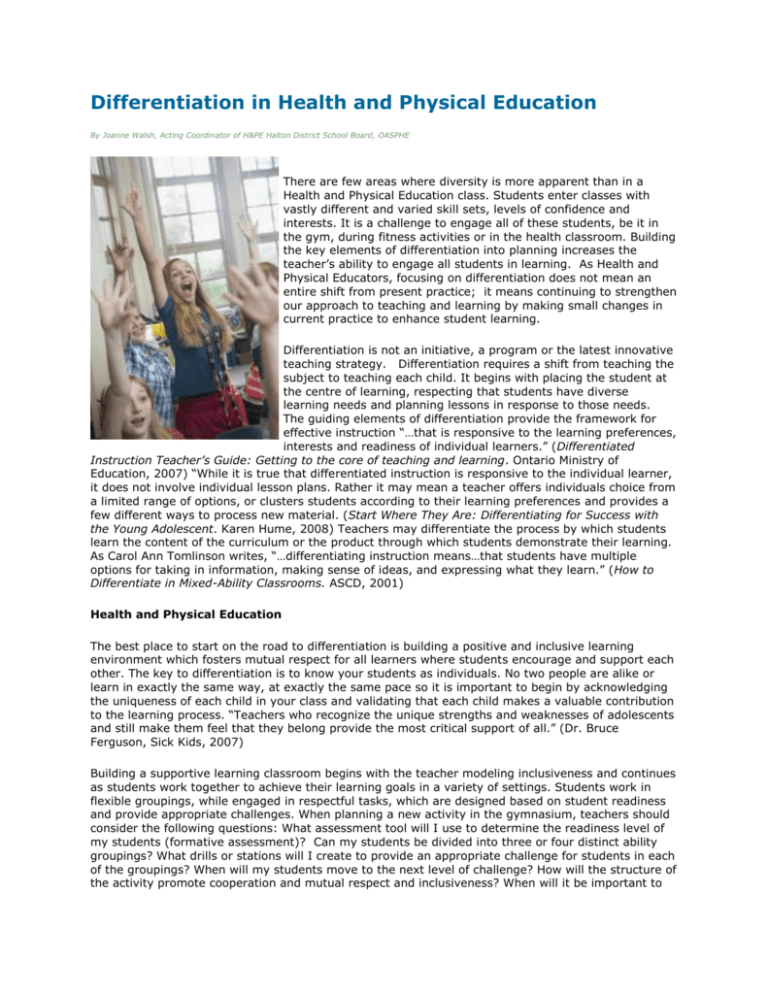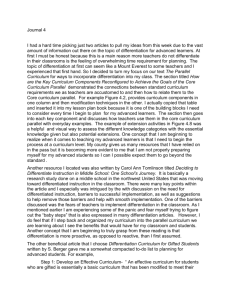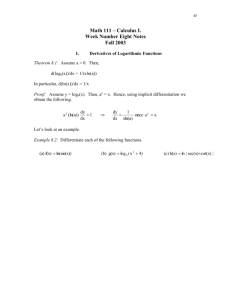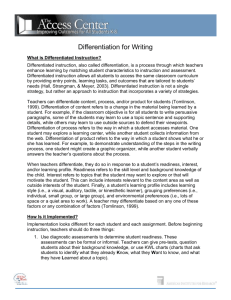DifferentiationinHealthandPhysicalEducation
advertisement

Differentiation in Health and Physical Education By Joanne Walsh, Acting Coordinator of H&PE Halton District School Board, OASPHE There are few areas where diversity is more apparent than in a Health and Physical Education class. Students enter classes with vastly different and varied skill sets, levels of confidence and interests. It is a challenge to engage all of these students, be it in the gym, during fitness activities or in the health classroom. Building the key elements of differentiation into planning increases the teacher’s ability to engage all students in learning. As Health and Physical Educators, focusing on differentiation does not mean an entire shift from present practice; it means continuing to strengthen our approach to teaching and learning by making small changes in current practice to enhance student learning. Differentiation is not an initiative, a program or the latest innovative teaching strategy. Differentiation requires a shift from teaching the subject to teaching each child. It begins with placing the student at the centre of learning, respecting that students have diverse learning needs and planning lessons in response to those needs. The guiding elements of differentiation provide the framework for effective instruction “…that is responsive to the learning preferences, interests and readiness of individual learners.” (Differentiated Instruction Teacher’s Guide: Getting to the core of teaching and learning. Ontario Ministry of Education, 2007) “While it is true that differentiated instruction is responsive to the individual learner, it does not involve individual lesson plans. Rather it may mean a teacher offers individuals choice from a limited range of options, or clusters students according to their learning preferences and provides a few different ways to process new material. (Start Where They Are: Differentiating for Success with the Young Adolescent. Karen Hume, 2008) Teachers may differentiate the process by which students learn the content of the curriculum or the product through which students demonstrate their learning. As Carol Ann Tomlinson writes, “…differentiating instruction means…that students have multiple options for taking in information, making sense of ideas, and expressing what they learn.” (How to Differentiate in Mixed-Ability Classrooms. ASCD, 2001) Health and Physical Education The best place to start on the road to differentiation is building a positive and inclusive learning environment which fosters mutual respect for all learners where students encourage and support each other. The key to differentiation is to know your students as individuals. No two people are alike or learn in exactly the same way, at exactly the same pace so it is important to begin by acknowledging the uniqueness of each child in your class and validating that each child makes a valuable contribution to the learning process. “Teachers who recognize the unique strengths and weaknesses of adolescents and still make them feel that they belong provide the most critical support of all.” (Dr. Bruce Ferguson, Sick Kids, 2007) Building a supportive learning classroom begins with the teacher modeling inclusiveness and continues as students work together to achieve their learning goals in a variety of settings. Students work in flexible groupings, while engaged in respectful tasks, which are designed based on student readiness and provide appropriate challenges. When planning a new activity in the gymnasium, teachers should consider the following questions: What assessment tool will I use to determine the readiness level of my students (formative assessment)? Can my students be divided into three or four distinct ability groupings? What drills or stations will I create to provide an appropriate challenge for students in each of the groupings? When will my students move to the next level of challenge? How will the structure of the activity promote cooperation and mutual respect and inclusiveness? When will it be important to have students of similar ability work together? When will it be important for students of diverse abilities to work together? A differentiated lesson accounts for the readiness level of each student. Prior experience with an activity gives students a firm starting point and leads to their success. However, students who lack these experiences need to be introduced to the activity in an enjoyable, engaging way to set a positive context for their learning. Beginning with modified versions of an activity/sport promotes inclusiveness, engages all students and creates a positive attitude toward the activity. The modified versions should also be structured so teachers can assess the skill level of each student. The teacher can then create playing opportunities and drills to address student readiness. Consider any Invasion/Territory game (e.g., soccer, basketball, field hockey, ball hockey) for which students need to acquire sending, receiving and travelling skills. Recognizing that students have differing levels of readiness, the teacher can create a series of stations in a circuit format, each ranging in degree of difficulty. This is known as Tiering. Students then choose their starting point in the circuit. As one version of the skill is mastered, students move to the next level of difficulty. The secret is that each works on developing the same basic skill e.g., dribbling. The first station may involve dribbling in a straight line, the second may involve dribbling between cones and the third may be dribbling against a defender. In each station, the students are practicing the same skill of dribbling; however, each student is challenged to succeed based on his/her own readiness level. Tiering allows students to progress to greater levels of difficulty at their own pace. Knowing the learning profile and interests of your students is also an essential element in planning for differentiation. Learning inventories may be used to help students understand how they prefer to process information, their intelligence preferences, whether they prefer to learn in a group setting or through independent inquiry, or their ability to learn through oral, visual or kinesthetic experiences. Additionally, a student’s interest peaks his/her motivation to explore ideas and concepts. Thus, the goal of differentiating lessons for different learners with varying interests is to offer a variety of choices so students may learn in ways that work best for them about topics of interest within the scope of the curriculum. The end result being an improvement in student learning. Tools for Differentiation A great motivational tool for students as they provide opportunities to explore facets of a topic that are of particular interest, are choice boards. These connect the learning to their own lives, allowing a sense of ownership and commitment to what they are learning. Choice boards focus learning on a particular aspect of the content and/or allow students to choose the way they demonstrate their learning (written, verbal or performance tasks). Created to use Gardner’s Multiple Intelligences, each square on the choice board requires students to explore a concept or demonstrate their learning using different intelligences. For example a choice board used to reinforce fitness concepts may have students create a word web for the fitness center wall which illustrates the key concepts of healthrelated fitness and their relationship to personal health (Verbal-Linguistic intelligence), or design a fitness plan that focuses on improving health-related fitness (Visual-spatial). A choice board may also be used to design tasks by which students demonstrate their understanding of concepts using their preferred intelligence. This lends itself particularly well to healthy living where students may create posters or mind maps, write journals, raps or poems or perform skits to demonstrate their understanding of a health concept. Cubing is a second powerful differentiation tool that provides a new twist on question asking and answering, and works well in a health and physical education setting. It may be used to; address readiness, activate student knowledge, review and summarize previous lessons, and assess learner preference/interest. A cube is created with a different question, task or activity on each side of it. A standard die may also be used to accompany index cards containing a numbered list of activities/questions that correspond to the number on the die. Students roll the dice and answer the corresponding question, or complete the task or activity. Cubing may be used to create fitness circuits that differentiate in varying levels of intensity or challenges, to provide practice for specific skills or to review a healthy living concept. Teachers can engage students’ interest further by having them develop the questions, tasks and activities for the cube. A third differentiation tool that provides students with a variety of options to demonstrate their understanding/learning of a “big idea” is a RAFT. RAFT is an acronym which stands for Role, Audience, Format and Topic. The teacher creates the format for various tasks that require students to adopt a specific role (e.g., youth leader), select an audience to whom they will communicate (e.g., a grade 9 student), choose the format for their communication (e.g., a poster), about a topic (e.g., how to make healthy choices when faced with pressure to engage in unhealthy behaviors). It is important to state a key concept of differentiation here. Although the demonstration of learning -the product - may look different from student to student, the curriculum expectations (or learning goals for students with an IEP), and the criteria by which the demonstration of learning is judged must remain the same. Regardless of the way students choose to demonstrate the learning, all students must demonstrate the acquisition of the same knowledge and skills (same expectation(s) and the product is judged using the same assessment tool e.g., checklist, rating scale or rubric. Differentiation is about providing a balance of strategies. It is about knowing when and how to differentiate. In fact, “there are many, many times when whole-class instruction is appropriate and preferable – and it has been suggested that differentiation to be effective and manageable can be implemented approximately 20% of the time. However, it is important to differentiate when it really counts e.g., big ideas – overall expectations, summative evaluations for culminating activities”. (Karen Hume, 2008). Just as students learn in different ways; students need to be given a variety of ways to express their learning. Three essential questions for the Health and Physical Educator to ask when considering how to differentiate include: How do I foster a positive and inclusive learning environment? What elements of the learning do I need to differentiate? How can I differentiate to be responsive to the readiness, the learner profile and the interests of my students? Differentiation is about all students “…getting the opportunities they need so they all have equal access to learning in a way that will lead to their success as well as opportunities to demonstrate their learning that maximize their potential for success.” (Differentiated Instruction Teacher’s Guide: Getting to the core of teaching and learning. Ontario Ministry of Education, 2007) There is no more important place for the differentiation for successful learning to occur than in Health and Physical Education where the goal of the curriculum is to help all students develop the comprehension, commitment, and capacity to lead a healthy active life.






